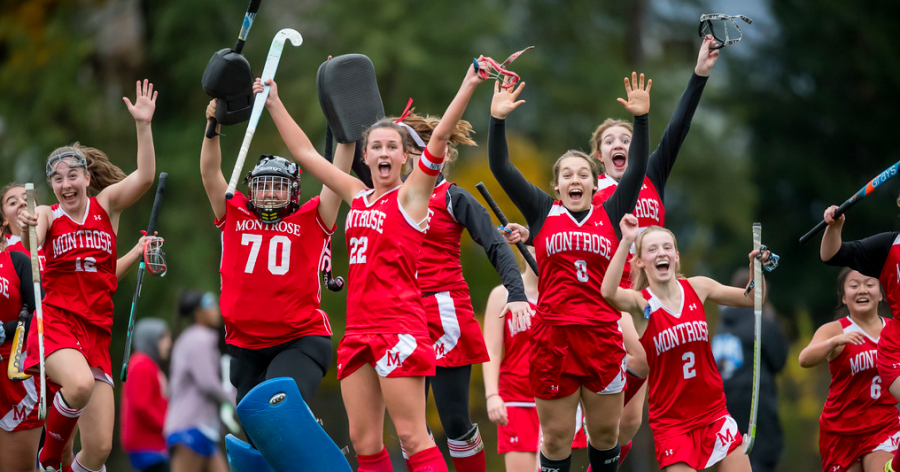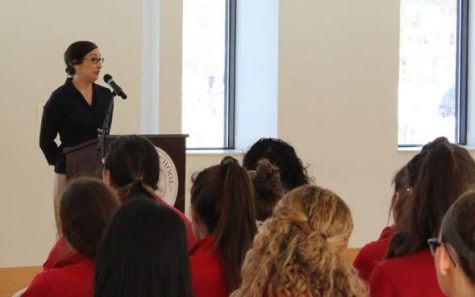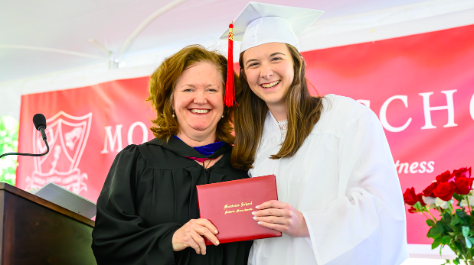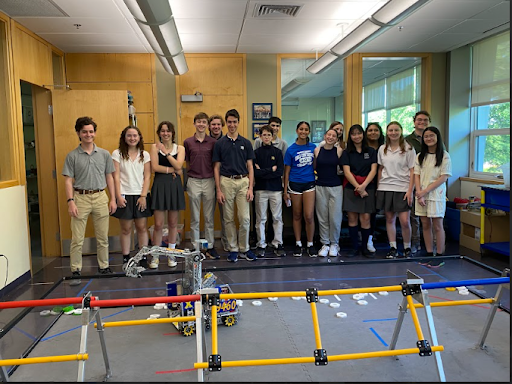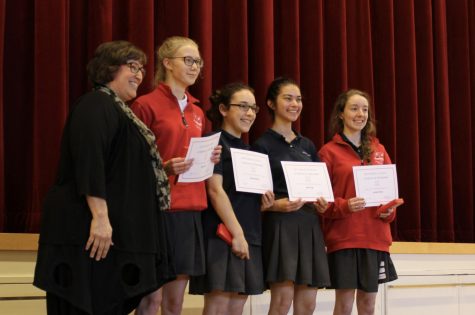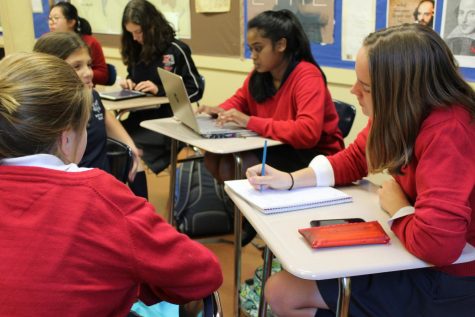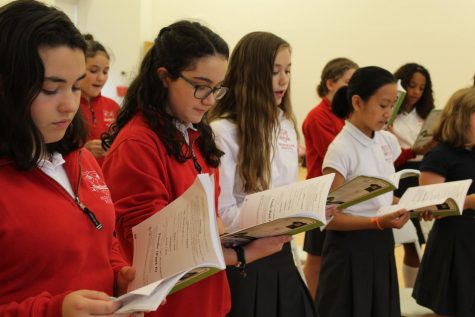A Historic Week in Review
Field Hockey Co-Captain and Co-Sports Editor Mary McManmon ’20 jumps for joy with her teammates after a game at McCarthy Field last fall.
“Exciting,” “different,” “uncomfortable,” and “mind-blowing” are just a few ways that members of the Montrose community have described our first week away from school. Students and teachers alike agree that adjusting to online learning has been a challenge. From our new Zoom classes, to an abundance of family time, these first few days have been filled with trial and error, inside and outside of our virtual classroom. In the end, we have learned lessons of solidarity amidst a time our school has not yet experienced in its history, and we will continue to grow and connect with each other in new ways.
Last Thursday morning, students and faculty gathered in the M&M Building to begin our last day of in-school classes. Head of School Dr. Bohlin called the entire school community to work together and stay connected during our time at home. She shared “5 P’s” for us to consider: Perspective, Permission, Patience, Prayer, and Peace. Undoubtedly, each of these words have guided the Montrose community in different ways throughout our first week.
Last Friday, Montrose faculty members spent the day discussing our transition into online classes and learning more about Zoom software. “Everything was building and adjusting,” said Associate Head of School for Faculty and Academics Ms White, who helped create the new schedule. She added: “We started prototyping schedules back in February. We surveyed teachers about what they needed, and brought drafts to faculty meetings so they could comment about it. We also met with an online learning committee that included teachers in humanities and sciences, as well as middle and high school.”
Learning the Ropes of Online Learning
By the time classes began on Wednesday, students had received a newly structured schedule for our online classes, and teachers had attended many workshops about hosting Zoom meetings and using Google Classroom for online assignments.
“The best part about this week was when I first logged on and got to see everyone’s faces again over Zoom on Wednesday,” said Upper School Math teacher Mrs. Hughes. Every year, Montrosians receive two days off while our teachers attend faculty meetings at school. “Quo Vadis” allows students to reflect and also spend some quality time with friends. Needless to say, this year’s Quo Vadis was like no other. Amidst social distancing, our usual Monday-Tuesday hiatus that occurred at the beginning of this week felt like a strange intermission period. By the time online classes began, many students and teachers felt excited to see each other again.
On Wednesday, students attended their first Zoom meeting: class-wide orientation led by our Grade Level Mentors (GLMs). Despite some technical difficulties, Zoom proved relatively easy to use after only a short orientation. Although it feels completely different from a regular school day, there may be some advantages to Zoom classes. French teacher and Chorus Director Ms Lechner said: “There’s an opportunity to open up and be real with each other on a different level. We’re all kind of vulnerable [through online meetings].”
At Montrose, most classes don’t require technology use. Although we use our laptops to type essays, send emails, or check our homework portal, we mostly rely on pen and paper for classwork and note taking. Specifically for our student body, a shift into full online learning has proven to be a transition full of new changes and plenty of learning along the way.
Mrs. Hughes, who has tutored singular students online before, explains her experience teaching a class of over twenty girls this week: “The biggest difference between tutoring and classes is that there’s a lot more people to teach at the same time. The functionalities of the Zoom calls don’t let you see everyone’s faces at once while you’re sharing screens, so I can’t see everyone’s facial expressions.”
Class discussions work completely differently through our laptop screens. With the Zoom software, teachers have the ability to use “screen sharing,” which allows them to utilize slideshows and other online resources while teaching. But during “screen sharing” mode, teachers can’t see every student at the same time, so it can be difficult to tell if a student is raising their hand. As a solution, most teachers encourage students to turn their microphone on and interrupt the lesson if they have a question. Unfortunately, many students feel less inclined to interrupt their teacher in the middle of a slideshow, so their question may go unanswered.
However, Zoom’s “chat box” has proved to be a positive aspect of online learning for students across the board. During virtual classes, teachers have the ability to share essential questions or article links in the chat box. Students also have the ability to type questions or comments in the chat box. If a student feels uncertain about interrupting a lesson, especially when their teacher can’t see that they are raising their hand, they can type it into the chat box instead. In many classes, students have also used the chat box to politely tell their teacher there are only a few minutes left of class, so that they can plan accordingly. As long as teachers check the chat box throughout class, it may prove to be an important advantage in online learning.
Taking a Break from Screens
With online learning, the amount of time we spend on screens everyday has enormously grown. Students and teachers alike have felt the impact of a long day of classes through a computer screen. Thankfully, our new schedule includes many pockets of free time to take a break from screens. Notably, the school day starts at 9 AM and classes end at 2:50 PM. As an added bonus, Mondays and Wednesdays have a late start at 10 AM.
As per Montrose tradition, the schedule also includes a half-hour break each day for Enrichment. At school, students have the opportunity to read a book in the Media Center or attend Mass in the chapel. But at home, students have much more freedom to choose how they spend the Enrichment period. Ms White said: “Initially, we thought about running activities during Enrichment. But we need to encourage students to take a break.” Faculty members encourage the girls to step away from their screens: go for a walk, exercise, or read a book.
Many students miss visiting our chapel and attending Mass in the mornings. Josie Marcucci ‘25 said: “We’ve been thinking about how lucky we are that we can go to Mass everyday. Normally it’s such a habit to go to Mass; I forgot that it was actually meaningful. I didn’t realize I’d feel sad about that — it’s one of the things I’ve missed.”
Montrose Faith Peer Leaders are hard at work to help students stay spiritually motivated at home. Weekly Rosaries, Fr. John’s YouTube channel, and the FPL Instagram page are all ways to connect with God at a time when the world needs our prayers. “There’s so much uncertainty right now, and it’s all new uncharted territory. Grounding yourself in faith and prayer helps you get through the process,” said Faith Peer Leader Catherine Bettinelli ‘21.
Montrosians may also choose to try meditation during the Enrichment period. Last week, Mrs. Kris offered a meditation session for students during Common Homeroom. She encouraged all students to continue practices of mindfulness and deep breathing. Mrs. Kris said: “Deep breathing is so worth it — not just for the brain, or the lungs, but for the whole body. It’s essential for us to take care of ourselves, and deep breathing is a great way to do that.” With the “square breathing technique” and free apps such as Headspace and the Insight Timer, there are numerous ways to try meditation during Enrichment.
The Homework Question
During the transition into online classes, some questions still remain. Notably, how much homework should teachers give to students? Now that we have much more free time on our hands, some may argue that assigning more homework can make up for any setbacks in the transition into online class time. It may help to keep us busy and feeling challenged. But as we have all experienced, it’s easy to feel much more exhausted than we’re used to when classes finish. At the end of a school day, we usually have the ability to socially recharge by saying goodbye to our classmates at our lockers and going to sports practices with our teammates. Now, our brains can feel overloaded with information and blue light.
Thanks to quarantine, all school work is “homework” now. Students and teachers are still working to balance the amount of schoolwork required each day. Alanna Hyatt ‘22 said: “[Our homework load] is probably about the same amount, or will be, but it feels easier because we have more time to do it.” While most agree with Alanna, Theresa Marcucci ‘23 noted that the freshman class has experienced a particularly heavy homework load since the transition to online classes. She said: “Teachers have the liberty to assign a lot of work since we have more time. It makes it feel like a lot.” Adjusting to the new system is a priority for both students and teachers, so it seems that homework has taken a backseat for the first few days.
Introducing: The Honor System
Another question: How should teachers give tests and quizzes? While at home, teachers don’t have the ability to monitor whether students use their notes, textbook, or the Internet during assessments. Also, if a student feels confused about something during a test or quiz, they don’t have the ability to ask their teacher for clarification in person.
Some teachers have already addressed this question. On Wednesday, 11th grade students in Ms Thordarson’s Honors Physics took a test. Students received a PDF of the test via email, printed it out, and completed the test during the class period. Then, they scanned their test and turned it in through Google Classroom. 11th grade Physics student Issie Russo ‘21 said: “I was happy [about the test] — Ms Thordarson trusts us; we’re mature enough.” Logistically, the honor system will probably play a role in any test or quiz that students receive during our time at home.
On Friday, Upper School students heard the latest update from the College Board about AP exams: this year, our usual 2-3 hour exams will only last 45 minutes. In addition, students will take their AP exams at home from their own computer. Undoubtedly, many test takers across the country may find ways to cheat on these exams. Thankfully, some Montrose teachers have already demonstrated that they trust their students enough to choose their own integrity over cheating. Montrose teachers will likely make more clarified decisions about the honor system while administering tests and quizzes over the next few weeks.
The Upsides
Through the uncertainties our world faces during the coronavirus pandemic, we have been given great opportunities to connect with others in new ways and come together as a community. As you may have seen in your schedule, some Enrichment periods will be dedicated to M-Block and Common Homeroom in the coming weeks. Even while we take our classes online, our school will always find ways to hold on to what brings us together. In addition, find time this week to schedule a Zoom meeting with your advisor to reconnect.
Student organizations from Student Government to Soldier Support plan on continuing meetings and finding ways to keep our student connection strong. Make sure to look for updates from different clubs in the upcoming week.
Without our usual busy schedules, and with college students returning home, many families have been able to spend much more time together. Theresa Marcucci ‘23, one of nine siblings, shared: “We’ve definitely had a lot more family time. It’s given us and everyone else in the world an opportunity to stop and reflect — not only reflect on a personal level, but on our entire world as a whole. That’s really important.”

